
Original Link: https://www.anandtech.com/show/1901
ATI MultiGPU Done Right: The Radeon X1800 CrossFire Edition
by Derek Wilson on December 20, 2005 9:00 AM EST- Posted in
- GPUs
Introduction
The Multi-GPU market is a very important one to a number of companies, yet it is presently only dominated by one: NVIDIA.
We have to hand it to NVIDIA, even though they had some problems with SLI early on, they managed to turn a slightly bumpy start into complete dominance of the Multi-GPU market in a year's time. And NVIDIA couldn't be happier; the incredible attraction to SLI, either from an upgrader's perspective or from the desire to have the absolute best in performance means that NVIDIA gets to sell one of their most expensive chipsets, and a potential of two GPUs to each customer. Three chips from one company in a single system? Only Intel had been able to accomplish such a feat in the past.
But what about ATI and their fabled CrossFire solution? Historically ATI hadn't done well at all at getting any sort of end user penetration with their chipsets, but they finally got somewhere with their latest CrossFire chipsets. What's even more amazing is that it wasn't the support for CrossFire that sold the motherboards either, it was the excellent overclocking features and end-user centric nature of the reference platform. CrossFire too might have been a success, had ATI done more copying of NVIDIA rather than taking a different approach this time around.
While the performance of the CrossFire X850 XT was respectable, the total package didn't make any sense. What we wanted was an ATI version of NVIDIA's SLI platform, instead we got a mess of master cards you couldn't buy and dongles that gave us more problems during testing than even the earliest SLI testing we did. And to make matters worse: there was a not-so-nice resolution limitation of 1600 x 1200, which is fine for mid-range offerings, but for a pair of Radeon X850 XTs running in parallel, you really need to be at higher resolutions to truly get the benefit of (at the time) $1000 worth of graphics cards. Even if you didn't heed our warnings, ignored the fact that NVIDIA's GeForce 7800 GTX was a better buy and still wanted a pair of X850 XTs on a CrossFire motherboard - you couldn't: the required master card wasn't available.
You know what they say, if at first you don't succeed... So we're back here today with the CrossFire solution that should have been: the ATI Radeon X1800 CrossFire Edition. The dongle is still there, as is the master card, but the resolution limit isn't and ATI's finally using a GPU that is a worthy competitor to the 7800 GTX. This time around, ATI has a chance and now, more than ever, do they need it.
The success of CrossFire means much more than whether or not ATI ends up at the top of some silly graphs; it will determine whether or not ATI has a chance at stealing away some of NVIDIA's very profitable Multi-GPU business. And believe it or not, CrossFire's success is very important to Intel. Intel's soon to be launched 975X platform will ship with full CrossFire support, but NVIDIA hasn't blessed it with SLI support, so Intel's only chance to be taken seriously as a high end gaming platform is with ATI's assistance.
A successful CrossFire could mean that Intel would have added leverage against NVIDIA, maybe even pressuring them into bringing SLI support to Intel's chipsets, as they would no longer have the exclusive on viable Multi-GPU. With both ATI and Intel very interested in the success of the launch, we're curious to see how it turns out. And we're sure you are too.
ATI: The A is for Availability?
Let's just say that we haven't been happy with ATI's promises of availability as of late. Generally speaking, we would often be promised availability for a certain date, and generally speaking that date would come and go, with nothing to show for it (definitely not in the sense of actual availability).
We and pretty much the rest of the press that ATI works with have been hounding ATI, demanding some accountability on their statements to us of availability. Because frankly, if we can't believe what they're telling us and you can't believe what they're telling us, then there's a serious problem. We've got some trust issues with ATI at this point, and luckily they seem intent on resolving them.
We've talked to ATI numerous times about availability, and prior to today's launch we had another discussion with them about the problem. They have promised that they have taken steps and precautions, internally, to once and for all resolve these availability problems. They stressed the difficulty of aligning a product launch with availability that very same day, but we countered with the fact that if they can put 330 million transistors to good use on a GPU, they can figure out how to make shipments arrive on time.
This latest launch is sort of a proving ground for our relationship with ATI, mainly with whether or not we can trust what they tell us. According to ATI, due to a customs issue, the shipments of CrossFire Edition X1800 cards were delayed from reaching the US last week. For this reason, ATI pushed the launch date back to today in order to follow through on their promise of a hard launch. In other words, today we should absolutely expect to be able to buy the CrossFire Edition X1800.
There's not much we can do other than wait and see, let's hope for ATI's sake that there is actual availability, in real quantities, sometime today. We will be keeping a close eye on what's happening with availability throughout the day, but right now let's find out if the X1800 CrossFire Edition is something worth buying to begin with.
The New Improved CrossFire
With the X1800 series of CrossFire cards, we will finally be able to test resolutions above 1600x1200. When it comes to multiGPU solutions, the more flexibility the user gets, the better. It is difficult to justify dropping over a thousand dollars on a setup that has limitations, and the removal of the single-link TMDS receivers definitely makes this version of CrossFire a more viable solution than its first incarnation in the X800 series.
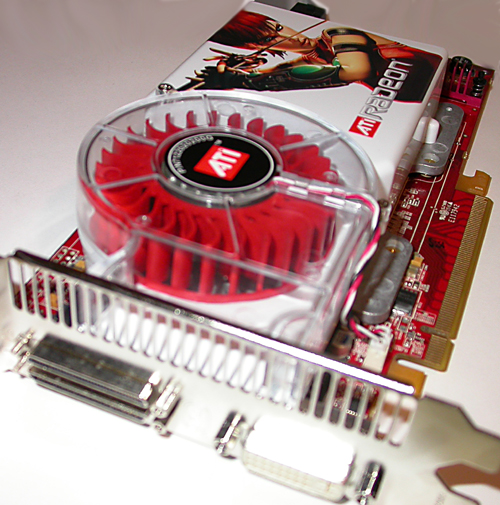
The addition of dual-link TMDS receivers on the master card marks the biggest upgrade we see on the X1800 version of CrossFire. With a new dongle connector, and the improved bandwidth of dual-link DVI, ATI has given their customers what they need to power huge resolutions. We will still be limited in performance on a game by game basis, as alternate frame rendering (AFR) is still the most efficient (and most restrictive) multiGPU mode in which to work. While ATI's Scissor and SuperTiling modes offer some flexibility and the extended SuperAA modes offer an alternate way to add value to games (enhancing quality rather than performance), there are some caveats we will mention in our performance analysis (in particular with Black and White 2).
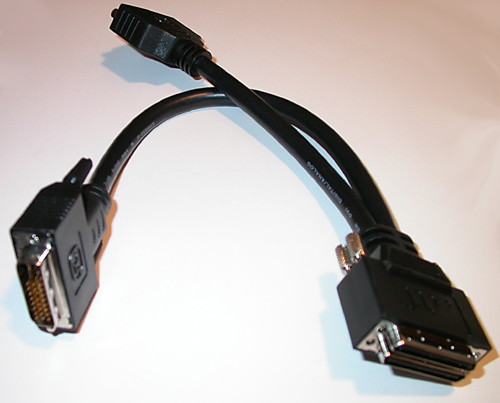
The basic features of CrossFire haven't changed from the initial design. For a refresher on CrossFire, check out our previous articles on the subject. Aside from the TMDS upgrades, ATI has refreshed their compositing engine with a larger FPGA from Xilinx. This allows ATI to composite the larger images possible with dual-link DVI input. Most of the rest of the CrossFire hardware is either unchanged or only slightly altered. From a board layout stand point, it would certainly make more sense if ATI were to build GPU to GPU communication into their parts as NVIDIA has done with SLI. Incorporating a silicon version of their compositing engine onto their GPUs would save board space and could improve performance even more.
From a high level, the X1800 CrossFire edition can be paired with a regular X1800 XT or an X1800 XL. There isn't a cheaper CrossFire card for the cheaper X1800 XL, and in order to get CrossFire setup and running with the X1800 XL, half of the RAM on the card needs to be disabled. In order to disable the RAM, the system needs to be rebooted, but in other cases CrossFire can be enabled and disabled without rebooting. While adding a CrossFire card to one's existing X1800 XL setup will definitely increase performance, it is ends up delivering even less for your money than when pairing it with an X1800 XT. The price tag is already a bit hefty, and we expect that most people who want this card will be those who need the absolute maximum performance possible. The value of CrossFire as an upgrade won't really be worth it unless the price of the X1800 CrossFire card comes down quite a bit.
The Test
For most of the cards we used the same configuration laid out in our GeForce 7800 GTX 512 review. Our driver, however, was not setup to allow CrossFire to run on an NVIDIA chipset (yes we tried). This forced us to go back to our reference RD480 CrossFire board used in the CrossFire launch article.
| CPU: | AMD Athlon 64 FX-57 (2.8GHz) |
| Motherboard: | ASUS A8N32-SLI Deluxe ATI Radeon Xpress 200 Crossfire Edition |
| Chipset: | NVIDIA nForce4 SLI X16 ATI RD480 |
| Chipset Drivers: | nForce4 6.82 Catalyst 5.12 Chipset Drivers |
| Memory: | OCZ PC3500 DDR 2-2-2-7 |
| Video Card: | ATI Radeon X1800 CrossFire Edition ATI Radeon X1800 XL ATI Radeon X1800 XT ATI Radeon X850 XT NVIDIA GeForce 7800 GT NVIDIA GeForce 7800 GTX NVIDIA GeForce 7800 GTX 512 |
| Video Drivers: | ATI Catalyst 5.12 (Beta) NVIDIA ForceWare 81.95 (WHQL) |
| Desktop Resolution: | 1280x960 - 32-bit @ 60Hz |
| OS: | Windows XP Professional SP2 |
| Power Supply: | OCZ PowerStream 600W PSU |
Battlefield 2 Performance
We don't have SLI numbers for this game because it seems the way we run or benchmark has problems with SLI. From some FRAPS gameplay analysis it is clear that SLI does improve BF2 performance, but it just doesn't show up in our timedemo for some reason. We are still working on this problem. We were able to see a benefit from CrossFire, and we didn't think it'd be fair to leave it out just because we couldn't get a proper picture of SLI performance. While CrossFire does offer an advantage over single X1k cards, the X1800 XT can't make significant gains over the single 7800 GTX 512 without AA enabled.
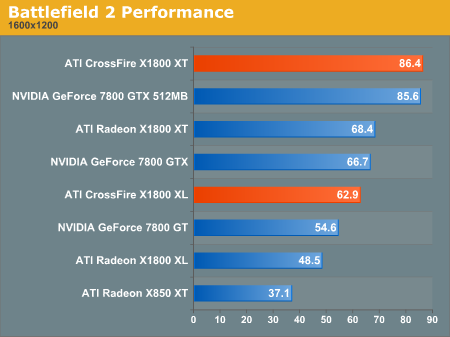
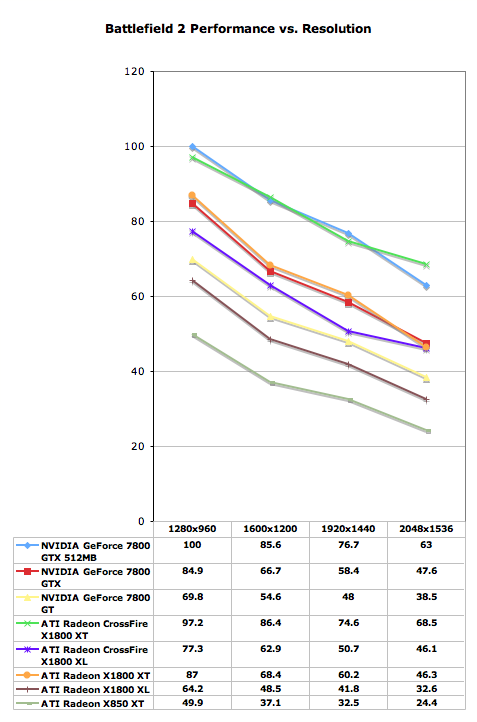
With AA enabled, CrossFire offers a bit more of an advantage over any single NVIDIA card. It is unfortunate that our test is unable to capture the affect of SLI on performance.
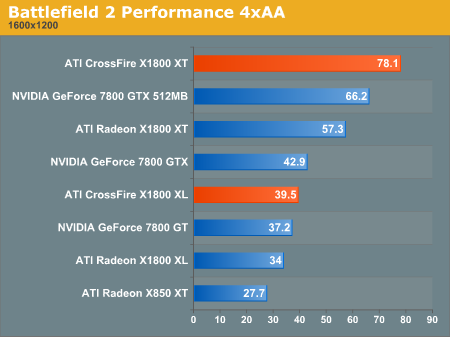
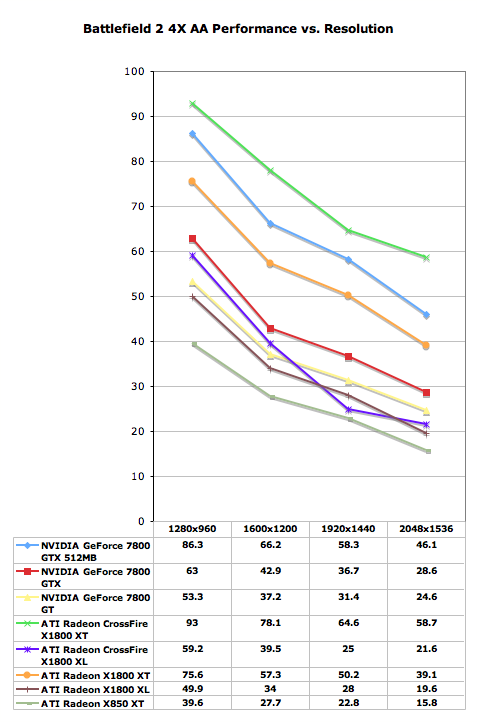
Black and White 2 Performance
Black and White 2 is completely unplayable with CrossFire. Anyone who has a CrossFire setup will need to disable it in order to get any kind of useful performance out of Black and White 2. We aren't exactly impressed with ATI's performance in general under this game, but it is clear that this game and ATI's multiGPU solution do not get along. SuperTiling is used for B&W2, and we really aren't sure why we are seeing this type of performance. It seems a bit odd to be inundated with red during BW2's ATI splash screen while performance is so abysmal.
The test was run with all the graphics options set on the highest level in all cases. We would hope to see ATI's latest generation handle high quality as well as their previous generation, and, whatever the problem is, someone needs to fix this. Only 1280x960 was tested because the performance was so low and because it was too difficult to even navigate the menu due to the low frame rate.
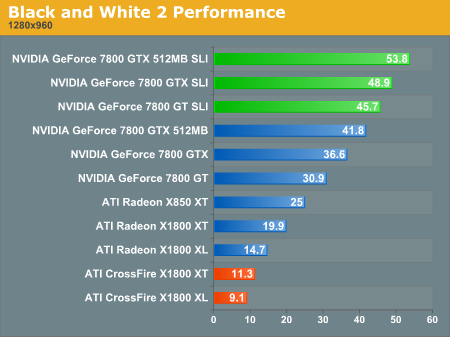
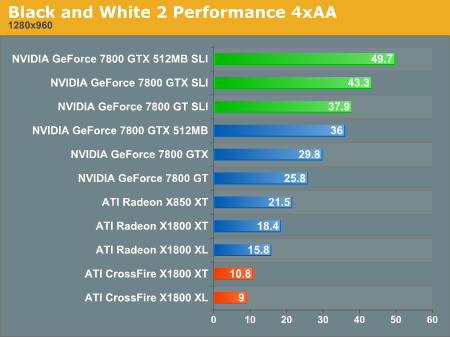
Day of Defeat Performance
Day of Defeat: Source seems to be hugely CPU limited with this kind of GPU power pumping through the game. This is especially true when running without antialiasing. Both of our tests have 8x anisotropic filtering enabled, but that doesn't seem to make a dent in any of our multiGPU configurations. We can see that CPU limited cases, SLI seems to incurr a little more CPU overhead. Thus the single card 7800 GTX 512 score is better than it's SLI performance.
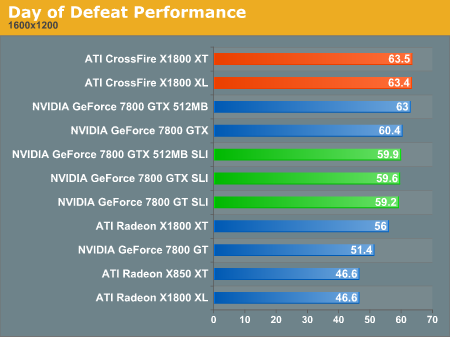
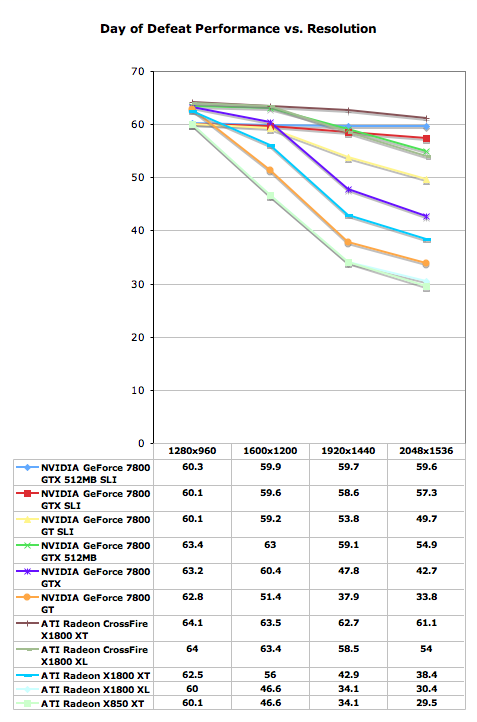
Under the antialiasing tests, there is a much more severe drop in performance after 1600x1200. All but the dual 512MB part configurations fell to under 50 FPS at 1920x1440. Under the highest stress conditions, the 7800 GTX 512 SLI manages to barely outperform the X1800 XT CrossFire, but the rest of data points to what we've seen many times before: ATI hardware performs very well under Valve's Source engine.
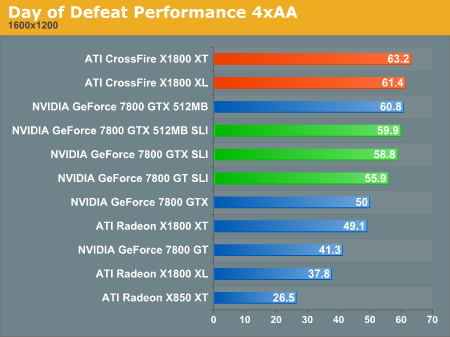
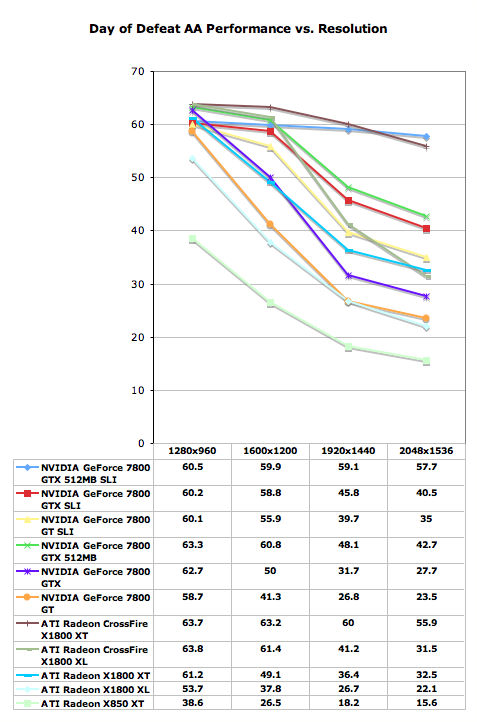
Doom 3 Performance
Doom 3, while CPU limited at lower resolutions, clearly shows the OpenGL engine still favors NVIDIA hardware when AA is disabled. In a recent Catalyst release, ATI made some huge improvements in OGL AA performance. But even at high resolutions here, the X1800 XT CrossFire struggles to keep up with the single 7800 GTX 512.
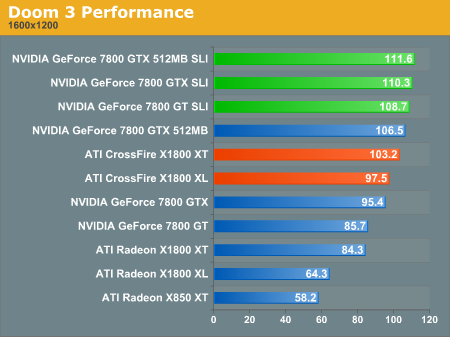
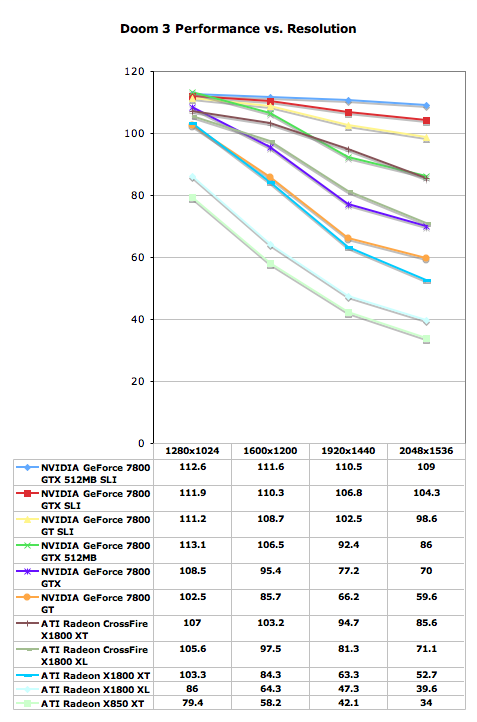
Enabling AA flips the table a little bit. While the 7800 GTX 512 SLI still comes out on top by a large margin (especially at high resolutions), the X1800 XT CrossFire is able to keep up with the 7800 GTX SLI solution. This mirrors the fact that the single X1800 XT is able to beat the 7800 GTX in all the resolutions we tested.
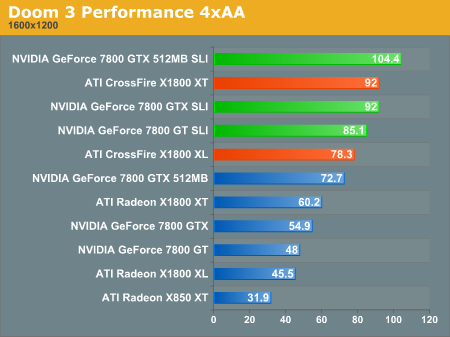
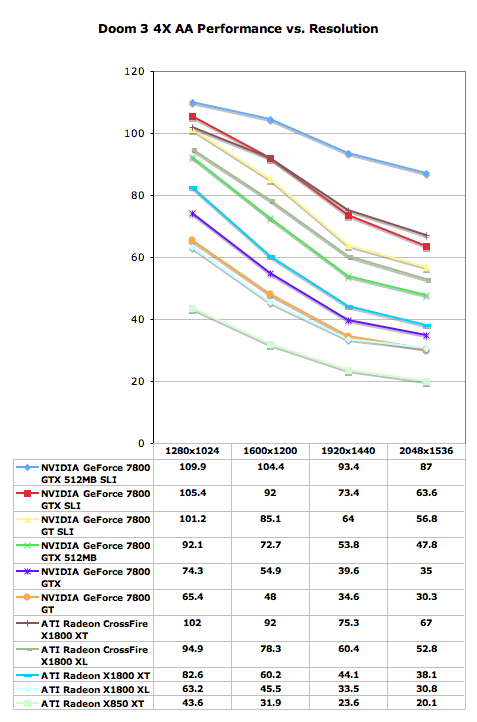
F.E.A.R. Performance
F.E.A.R. is an incredibly demanding game graphically if all the options are flipped on. Without Soft shadows and AA enabled, our graphs show that the ATI multiGPU configurations are able to hang right with their NVIDIA SLI counterparts. It seems that resolutions above 1600x1200 stress CrossFire a little more than SLI, as the ATI multiGPU numbers seem to drag a little lower in those cases.
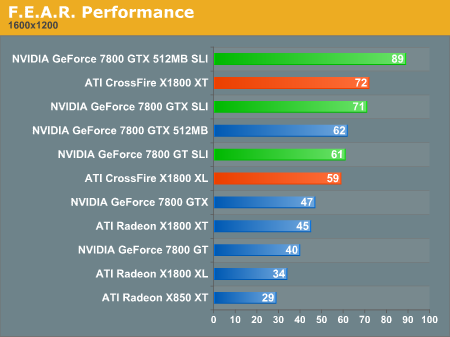
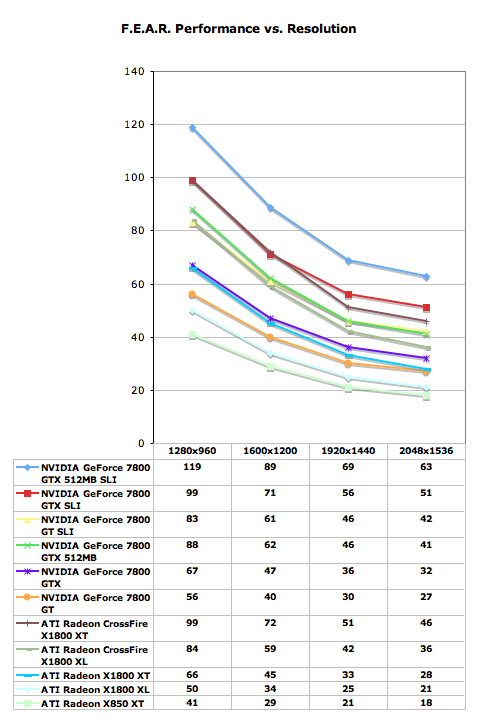
When 4xAA is kicked on in the in game settings, the X1800 XT CrossFire configuration is almost able to touch the performance of the 7800 GTX 512 SLI. Interestingly, performance of the X1800 XL CrossFire drops tremendously above 1600x1200. This difference could be dependent on the extra memory the XT version has to play with.
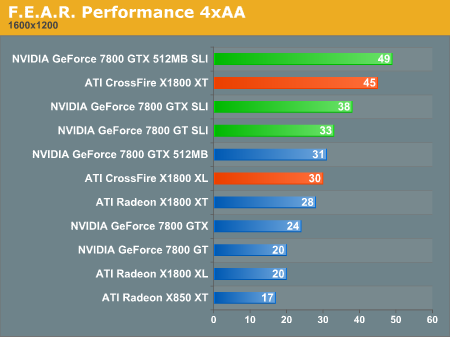
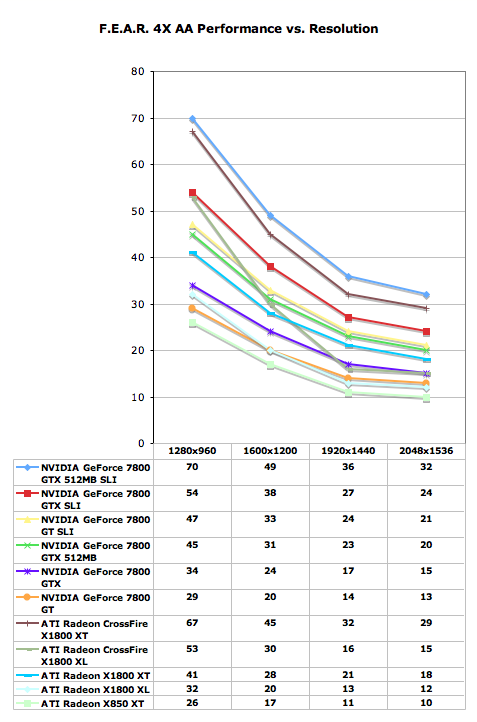
Splinter Cell: Chaos Theory Performance
This test was run in SM3.0 mode with all the options on. The 1.05 version of SC3 was used, and we ran the built in lighthouse timedemo. For our non AA test, no AF was enabled either (all our other tests have 8xAF or "high" texture filtering where no numeric option is available). Without AA and AF, everything looks fairly evenly spaced, with the CrossFire numbers splitting the difference between their direct competition and the next step up. This is fairly impressive, but the AA test shows an even more interesting landscape.
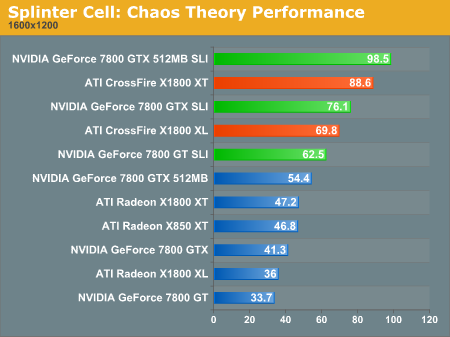
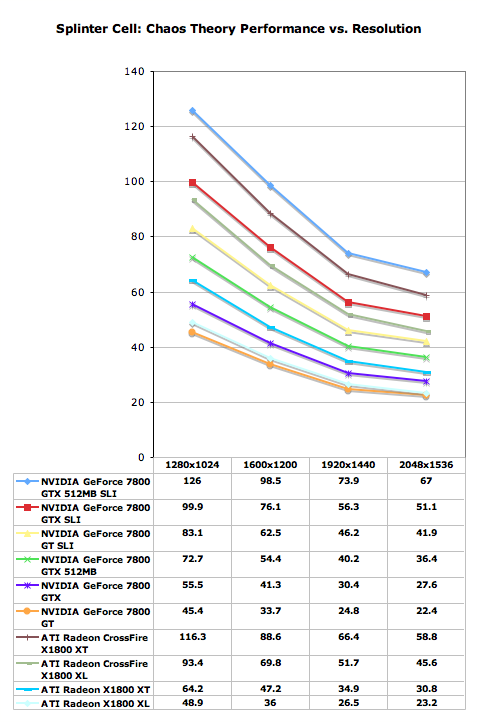
After 4xAA and 8xAF are enabled, the X1800 XT CrossFire performs identically to the 7800 GTX 512 SLI. The X1800 XL CrossFire even manages to lead the 7800 GTX SLI. This is right in line with the single card performance, which means that SLI and CrossFire are both able to handle Splinter Cell with the same level of efficiency.
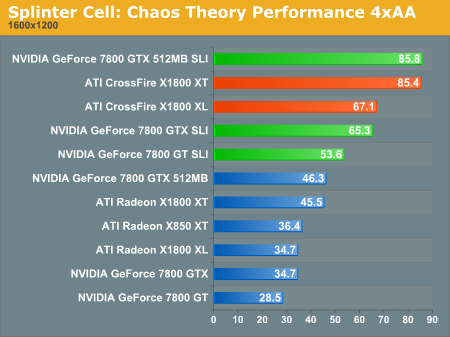
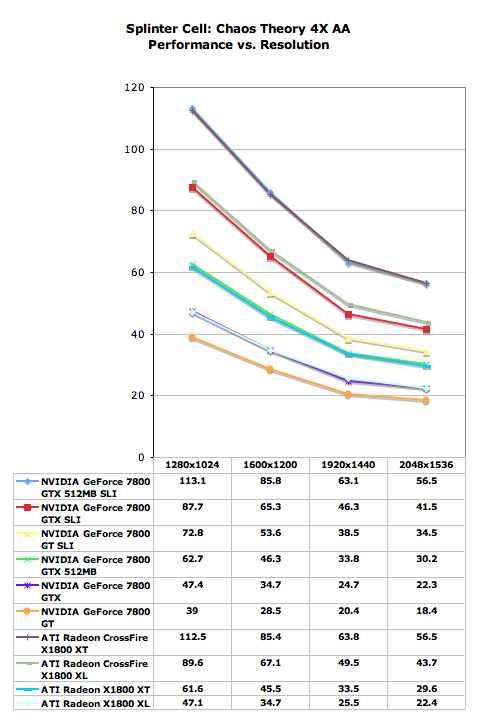
Quake 4 Performance
The Quake 4 benchmark looks a lot like Doom 3 in terms of how everything falls out. Quake 4 seems just a little bit more GPU limited at lower resolutions, but everything stacks up just about the same.
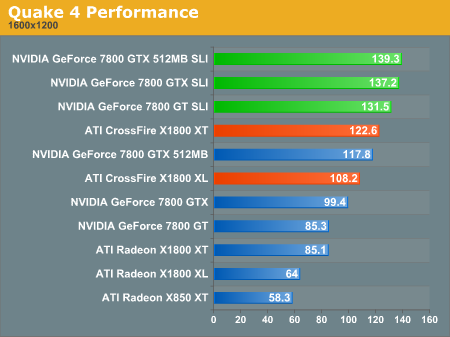
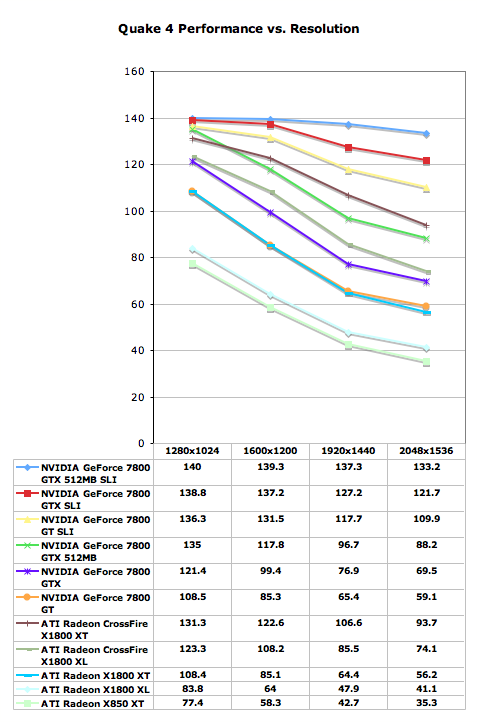
Even with 4xAA enabled, low resolutions get huge frame rates. And, again, the cards perform much as they did under Doom 3.
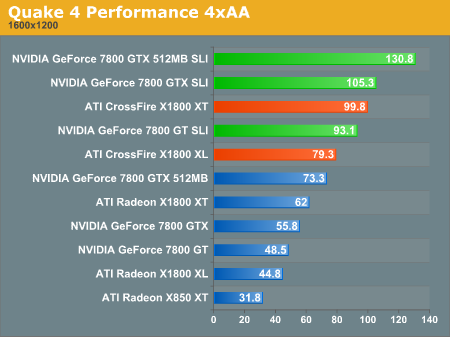
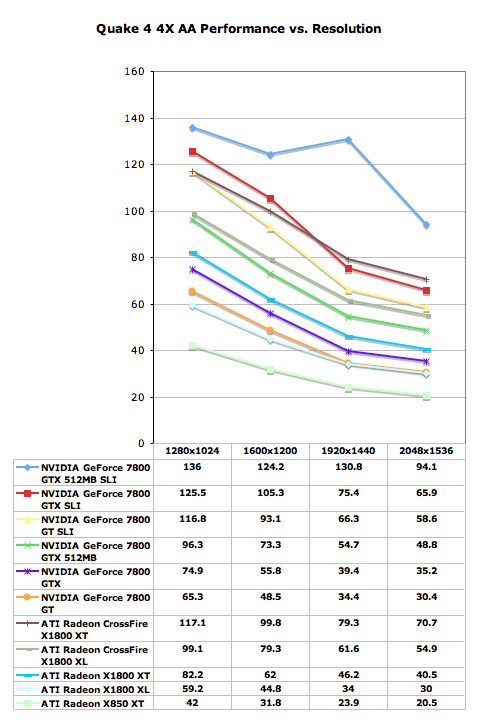
Final Words
SLI was not without its hiccups at the outset. Since NVIDIA launched its dual GPU solution a year ago, things have only gotten better. The first few months of CrossFire have shown us that ATI is struggling down the same road that NVIDIA set out on with SLI. The first version of CrossFire wasn't as refined as we had hoped it would be, but everyone has to start somewhere. The X1800 CrossFire Edition card shows that ATI is making significant progress in the multi GPU arena.
The system level problems and difficulty we had with the initial version of CrossFire were largely solved this time around, as (after a proper BIOS update) we had no trouble enabling CrossFire or getting it running. The reboot required for getting the card to work with the 256MB X1800 XL is a bit of a step backward, but it's nothing major. Super AA modes work, but aren't worth it in games that see a performance benefit from more than one GPU. These modes haven't changed from the original X800 CrossFire release, but now AA mode blending is done in hardware as well.
Unfortunately, there are still some real down sides. Aside from not hurting performance, there should be absolutely no game that suffers a performance hit from enabling CrossFire. This kind of problem was one of the issues we saw with NVIDIA's SLI when it first came out and selecting the wrong mode could cause performance issues (though we never saw anything as dramatically catastrophic as CrossFire's performance under Black and White 2). Hopefully ATI can fix all of this with some additions or changes to the application detection in Catalyst A.I.
There isn't as much capacity for customization of how CrossFire affects a particular game. Sure, we could probably figure out how to perform some sort of registry hack to force CrossFire to enable a specific mode, but NVIDIA's drop down menu is so much more efficient. I do agree that it is usually best to let the driver and application figure out what to do, but clearly there are some cases where things can go wrong. More finely grained customization is something we have been looking for from ATI in general, but as systems get more complex (such as in the case of multi GPU solutions), it is even more important to give the end user more control with solid default functionality.
We still don't like the external dongle as much as NVIDIA's internal bridge (especially the flexible kind). While our lab sports an excessive number of cables running everywhere, we are sure that less clutter behind the machine is better for everyone. And GPU to GPU communication does have board space and other advantages as well. Thankfully, this time around we are able to squeeze dual-link DVI bandwidth in to and out of the cable. While mastercardless CrossFire is in ATI's future, it is unclear yet what kind of performance or quality impact this will have on the overall solution.
Performance is one of the high points of CrossFire in general. In many cases, the X1800 XT in CrossFire performs between the 7800 GTX SLI and 7800 GTX 512 SLI setups. Things may heat up even more when ATI brings out its R500 series refresh part to compete more directly with NVIDIA's top of the line king of the hill GeForce 7800 GTX 512.
But price is still an issue for ATI at the high end. With the 7800 GTX selling for between $450 and $500, finding two that fall somewhere between $900 and $1000 isn't a difficult task. With the X1800 CrossFire Edition at about $600 and the price of standard X1800 XT running between $500 and $550, shelling out $1100 or more dollars for CrossFire isn't a stretch. Unless the system is just made to eat money, one or two hundred dollars is a good savings for a comparable solution that is much more mature. And for those who want the best of the best (and really can afford to burn money), that's still going to be the $1400 dual 7800 GTX 512 setup.
And above all of this looms the shadow of availability. After an early morning look around, it doesn't look good. Some vendors have X1800 CrossFire Edition cards listed on their site, but they are all showing out of stock, back ordered, or early January ETAs on parts. With previous NVIDIA launches, we have seen product available for purchase before we published. With the 7800 GT launch, we even had parts listed for sale in our RTPE the weekend before we could talk about it. Without seeing anywhere to physically buy the hardware just hours before it is supposed to be publicly available does not give us a warm and fuzzy feeling about ATI's promises. But we are good sports, so we will keep checking throughout the day for any sign of an online vendor actually selling parts. ATI knows how important this launch is in earning some level of trust back from the press and their customers. All we can do at this point is hope that translates into results.
UPDATE: To put things bluntly, we aren't exactly certain how to react to this luanch. On Tuesday, there was very limited availability at one or two online retailers. Most major sites listed availability as "out of stock" or "backorder", but if you looked hard enough you could find a card for sale. We have to give ATI credit for this, as its much more than we've seen in the past. The day after launch more sites have the X1800 CrossFire edition available for immediate purchase. The situation is a little better, but not quite on par with the 7800 GT or 6800 GS launches. We all know the 7800 GTX 512 is all but impossible to find right now, but people who got in there quickly were able to get product at launch. Neither the 7800 GTX 512 situation nor this X1800 CrossFire launch are what we really want: immediate availability of parts in high enough quantities to at least to meet demand. Yes, it is quite a bit to ask, but NVIDIA has shown us it can be done with 7800 GTX, GT, and 6800 GS launches. Yes, it is the holiday season, so we understand that the pressure and difficulty of delievering what we want is increased orders of magnitude over the already difficult process of hard launching a part. So what's our final assesment?
For now, this is enough. We commend ATI for coming through and getting some cards out there at launch. But we still want to see more improvement in the future.







